0. 初衷
只是简单分享一下顶点着色器做的事情,和大概能做的事情 并不是真的想模拟一个真正的云海,毕竟对比 RAYMarching 体积云之类的效果来说还是差很多 这里用一个小 demo,来一步步编写顶点着色器,实现修改模型的形状 一起来了解一下 mesh 模型,顶点着色器,片元着色器,噪声之间的作用
1.1 选用这个来作为开篇的理由很简单
- Mesh 形状是矩形,只是当中三角形很多,所以很容易想象出结构
- 顶点着色器只修改了模型的 Y 轴,没有做过多的改变
- 顶点着色器的变化只是从噪声贴图中获取改怎么变,没有使用复杂的公式计算,所以也很容易想象
- 片元着色器更简单,只是返回了顶点着色器输出的 v_color,顶点着色器输出的值会根据重心坐标进行差值
- 噪声是一个只有黑白灰的图片,所以也很容易理解
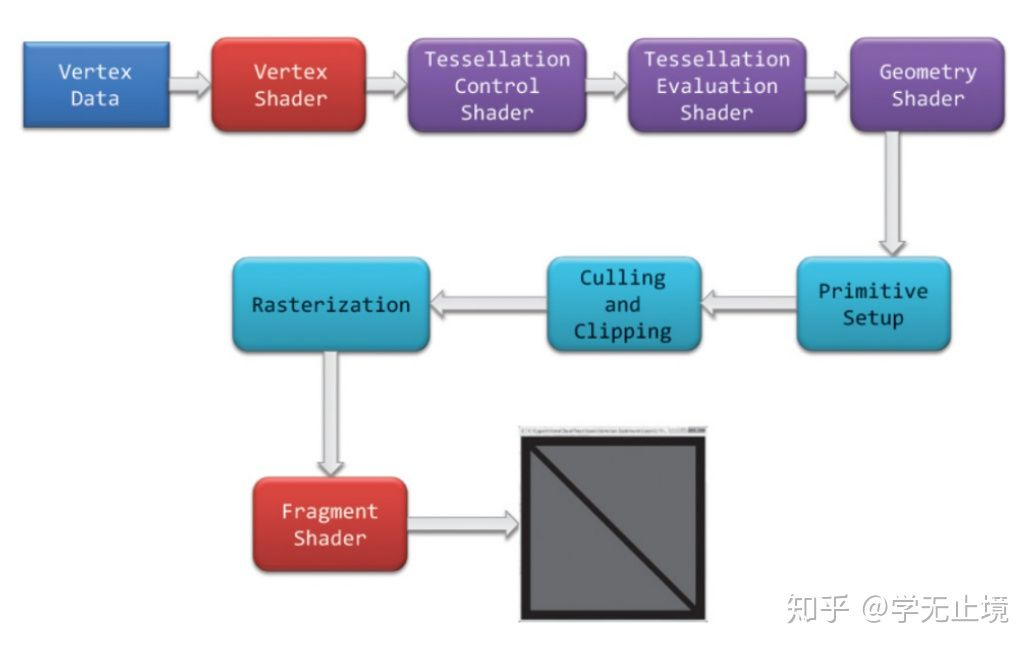 image
image
1. 效果预览
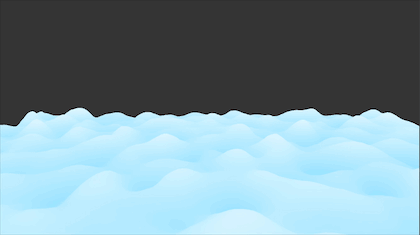 QQ20220115-185126
QQ20220115-185126
2. 思考
- GPU 渲染的是一个一个的三角形
- 一个面只要顶点够多,就能生成一个平滑的曲面 -- 在低端机可以让三角形【顶点】少一些
- 动态生成一个 mesh,是一个平面,并且三角形足够的多
- 通过一张外部图片【噪声】的信息,来存储云的凹凸信息 -- 一张图只有黑白灰,越白的地方,让三角形的高度越高,反之亦然
- 让这张贴图运动【滚动】起来,随着时间的变化,修改获取 uv 的位置信息 -- 这样三角形就可以变化了
- 通过读取多张噪声,或者读取同一张噪声不同位置的地方,叠加起来,就可以获得翻涌的感觉了
3. 行动
多说无益,实践才是最好的
3.1 首先创建默认的场景,材质,和 effect 文件
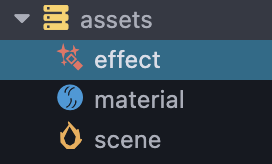 image
image
3.2 编辑 effect 文件
双击打开 effect, 获得了默认的 cocos 的 shader 文件
1
2
3
4
5
6
7
8
9
10
11
12
13
14
15
16
17
18
19
20
21
22
23
24
25
26
27
28
29
30
31
32
33
34
35
36
37
38
39
40
41
42
43
|
CCEffect %{
techniques:
- name: opaque
passes:
- vert: general-vs:vert # builtin header
frag: unlit-fs:frag
properties: &props
mainTexture: { value: white }
mainColor: { value: [1, 1, 1, 1], editor: { type: color } }
- name: transparent
passes:
- vert: general-vs:vert # builtin header
frag: unlit-fs:frag
blendState:
targets:
- blend: true
blendSrc: src_alpha
blendDst: one_minus_src_alpha
blendSrcAlpha: src_alpha
blendDstAlpha: one_minus_src_alpha
properties: *props
}%
CCProgram unlit-fs %{
precision highp float;
#include <output>
#include <cc-fog-fs>
in vec2 v_uv;
uniform sampler2D mainTexture;
uniform Constant {
vec4 mainColor;
};
vec4 frag () {
vec4 col = mainColor * texture(mainTexture, v_uv);
CC_APPLY_FOG(col);
return CCFragOutput(col);
}
}%
|
可以看到一行 - vert: general-vs:vert # builtin header 根据后面的注释,可以知道,这里使用了默认的 builtin 的顶点着色器 参考 cocos 官方文档: https://docs.cocos.com/creator/3.3/manual/zh/material-system/effect-syntax.html#pass-%E4%B8%AD%E5%8F%AF%E9%85%8D%E7%BD%AE%E7%9A%84%E5%8F%82%E6%95%B0
所以这个文件里面缺少了要编写的顶点着色器,所以要手动补充一个 找到自带的chunks里面的general-vs
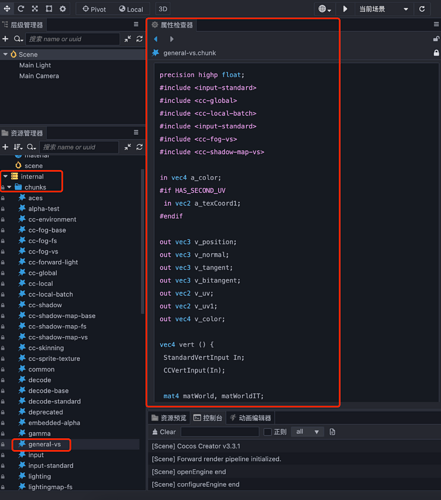 image
image
将内容复制出来 回到 effect 文件中,补充一个CCProgram块 my-vs
1
2
3
4
5
6
7
8
9
10
11
12
13
14
15
16
17
18
19
20
21
22
23
24
25
26
27
28
29
30
31
32
33
34
35
36
37
38
39
40
41
42
43
44
45
46
47
48
49
50
51
| CCProgram my-vs %{
precision highp float;
#include <input-standard>
#include <cc-global>
#include <cc-local-batch>
#include <input-standard>
#include <cc-fog-vs>
#include <cc-shadow-map-vs>
in vec4 a_color;
#if HAS_SECOND_UV
in vec2 a_texCoord1;
#endif
out vec3 v_position;
out vec3 v_normal;
out vec3 v_tangent;
out vec3 v_bitangent;
out vec2 v_uv;
out vec2 v_uv1;
out vec4 v_color;
vec4 vert () {
StandardVertInput In;
CCVertInput(In);
mat4 matWorld, matWorldIT;
CCGetWorldMatrixFull(matWorld, matWorldIT);
vec4 pos = matWorld * In.position;
v_position = pos.xyz;
v_normal = normalize((matWorldIT * vec4(In.normal, 0.0)).xyz);
v_tangent = normalize((matWorld * vec4(In.tangent.xyz, 0.0)).xyz);
v_bitangent = cross(v_normal, v_tangent) * In.tangent.w;
v_uv = a_texCoord;
#if HAS_SECOND_UV
v_uv1 = a_texCoord1;
#endif
v_color = a_color;
CC_TRANSFER_FOG(pos);
CC_TRANSFER_SHADOW(pos);
return cc_matProj * (cc_matView * matWorld) * In.position;
}
}%
|
并且将最上面的 CCEffect 的 vert 部分定义修改成
1
2
3
4
5
6
7
8
9
10
11
12
13
14
15
16
17
18
19
20
21
22
| CCEffect %{
techniques:
- name: opaque
passes:
- vert: my-vs:vert
frag: unlit-fs:frag
properties: &props
mainTexture: { value: white }
mainColor: { value: [1, 1, 1, 1], editor: { type: color } }
- name: transparent
passes:
- vert: general-vs:vert
frag: unlit-fs:frag
blendState:
targets:
- blend: true
blendSrc: src_alpha
blendDst: one_minus_src_alpha
blendSrcAlpha: src_alpha
blendDstAlpha: one_minus_src_alpha
properties: *props
}%
|
3.3 绑定 effect 到材质上
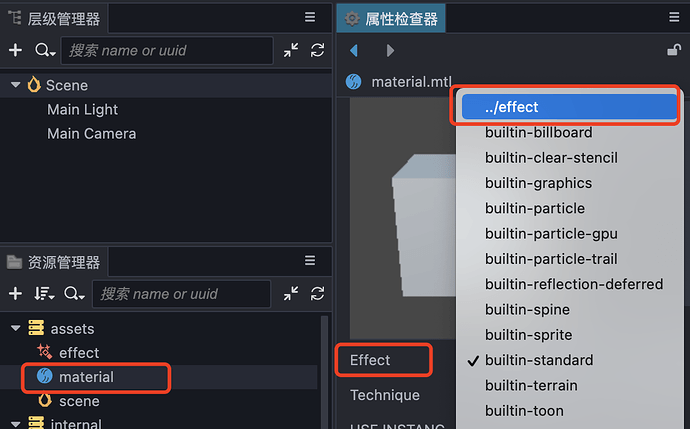 image
image
选中材质,选择 Effect,选中刚刚新建的 effect 文件,最后不要忘记点击右上角的箭头,保存一下 正确的话会预览出一个纯白的方块
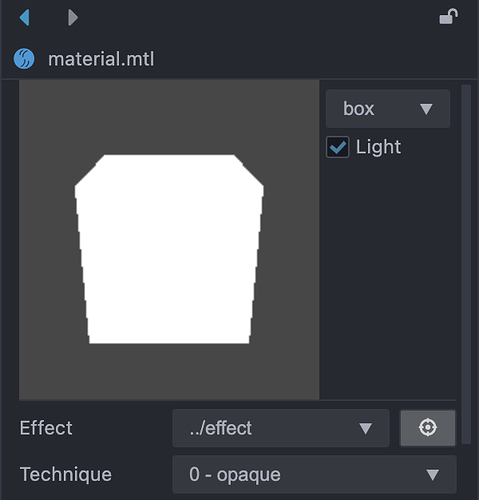 image
image
3.4 创建 plane,并应用材质
 image
image
场景中创建 3D 对象,Plane
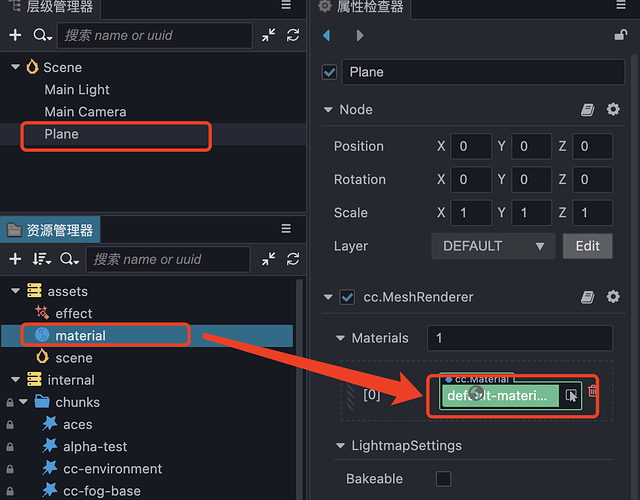 image
image
选中 Plane 节点,将 material 拖拽覆盖原本的 default-material 材质
 image
image
最终可以得到一个纯白的 Plane
3.5 准备噪声贴图
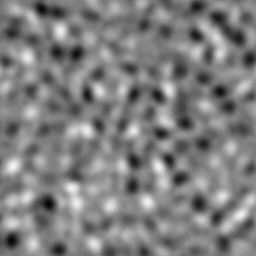
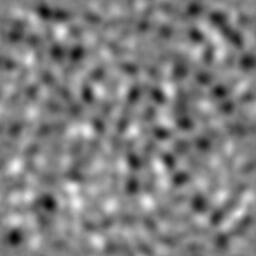
这里有两张噪声,简单看上去,他们好像并没有区别,但是如果让 UV 偏移 0.5 的话就会发生奇怪的问题 先简单修改下片元着色器,也就是 frag 块
1
2
3
4
5
6
7
8
9
10
11
12
13
14
15
16
17
18
| CCProgram unlit-fs %{
precision highp float;
#include <output>
#include <cc-fog-fs>
in vec2 v_uv;
uniform sampler2D mainTexture;
uniform Constant {
vec4 mainColor;
};
vec4 frag () {
vec4 col = mainColor * texture(mainTexture, v_uv + 0.5);
CC_APPLY_FOG(col);
return CCFragOutput(col);
}
}%
|
3.5.1 修改了 UV 的取值
这里将 v_uv 增加了 0.5
3.5.2 回到 cocos creator 编辑器,将两张噪声分别放进材质里,看看会发生什么
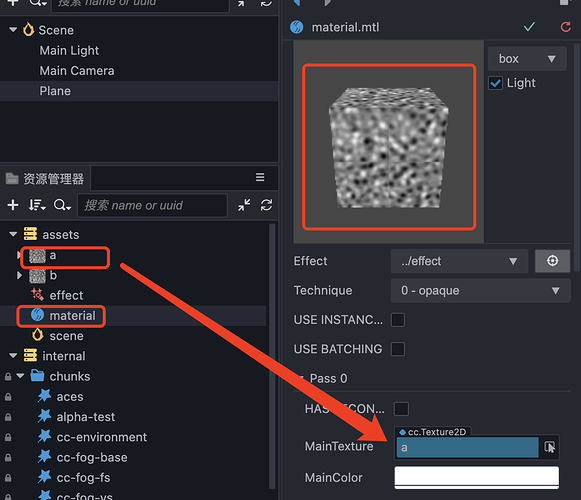
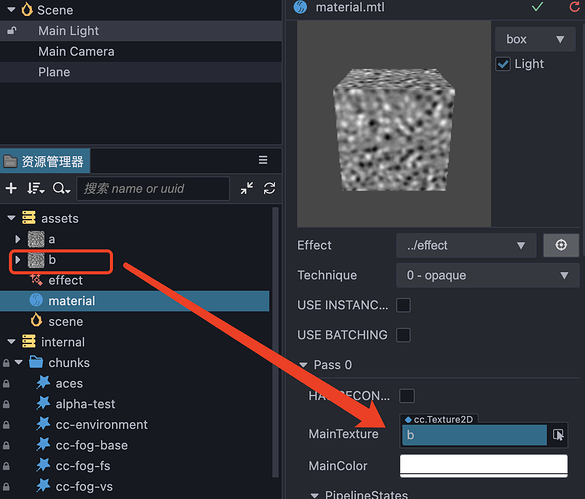
可以很明显的发现噪声在偏移之后,中间并不平滑 所以这里使用的噪声贴图有一个条件:无缝噪声
测试完记得吧+0.5 删掉 测试完记得吧+0.5 删掉 测试完记得吧+0.5 删掉
3.6 修改顶点着色器,让顶点位置发生变化
1
2
3
4
5
6
7
8
9
10
11
12
13
14
15
16
17
18
19
20
21
22
23
24
25
26
27
28
29
30
31
32
33
| uniform sampler2D mainTexture;
vec4 vert () {
StandardVertInput In;
CCVertInput(In);
mat4 matWorld, matWorldIT;
CCGetWorldMatrixFull(matWorld, matWorldIT);
vec4 p = In.position;
float y = texture(mainTexture, a_texCoord).x;
p.y = y;
vec4 pos = matWorld * p;
v_position = pos.xyz;
v_normal = normalize((matWorldIT * vec4(In.normal, 0.0)).xyz);
v_tangent = normalize((matWorld * vec4(In.tangent.xyz, 0.0)).xyz);
v_bitangent = cross(v_normal, v_tangent) * In.tangent.w;
v_uv = a_texCoord;
#if HAS_SECOND_UV
v_uv1 = a_texCoord1;
#endif
v_color = a_color;
CC_TRANSFER_FOG(pos);
CC_TRANSFER_SHADOW(pos);
return cc_matProj * (cc_matView * matWorld) * p;
}
|
3.6.1 定义 mainTexture
uniform sampler2D mainTexture;
3.6.2 定义 p = In.position; 并且用 p 代替后续代码中的 In.position
3.6.3 读取 mainTexture 中对应 UV 位置的颜色,由于是黑白灰的噪声,所以 r==g==b,直接将 r 的颜色赋值给 p.y
3.6.4 后续不要忘记使用 p 来代替 In.position 来计算
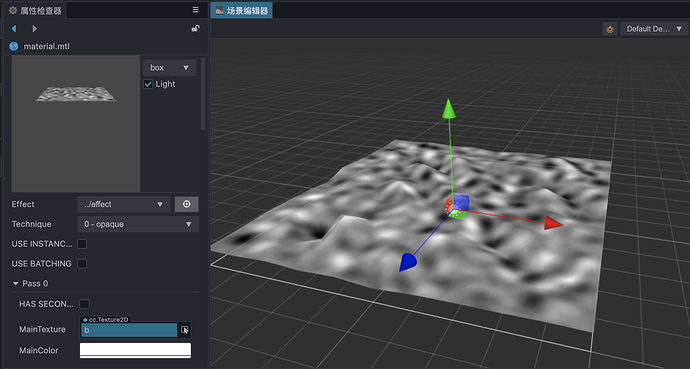 image
image
回到 cocos creator 就可以发现 Plane 变的凹凸不平,并且越黑的地方越低,越白的地方越高
3.7 平滑
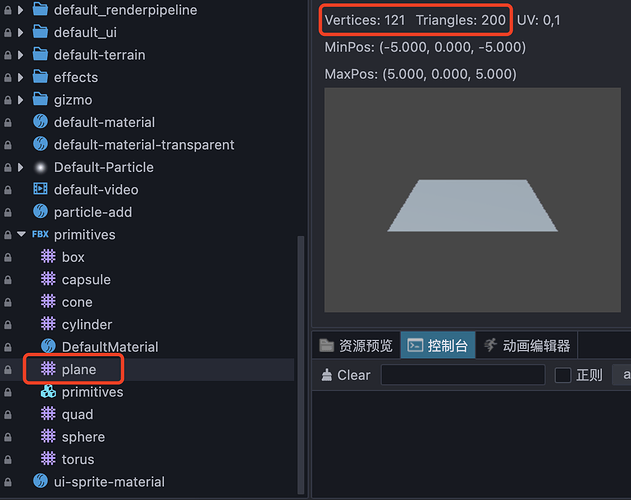 image
image
默认的 Plane 面数比较少,所以会变的比较不平滑
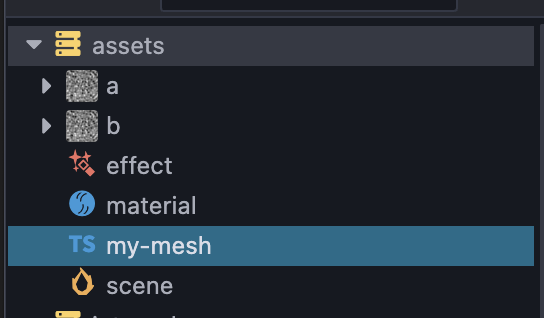 image
image
创建一个脚本,叫 my-mesh,用来替换 plane 的默认 mesh
1
2
3
4
5
6
7
8
9
10
11
12
13
14
15
16
17
18
19
20
21
22
23
| import { _decorator, Component, utils, primitives, MeshRenderer } from 'cc';
const { ccclass, property } = _decorator;
@ccclass('MyMesh')
export class MyMesh extends Component {
start () {
const renderer = this.node.getComponent(MeshRenderer);
if(!renderer){
return;
}
const plane: primitives.IGeometry = primitives.plane({
width: 10,
length: 10
widthSegments: 100,
lengthSegments: 100,
});
renderer.mesh = utils.createMesh(plane);
}
}
|
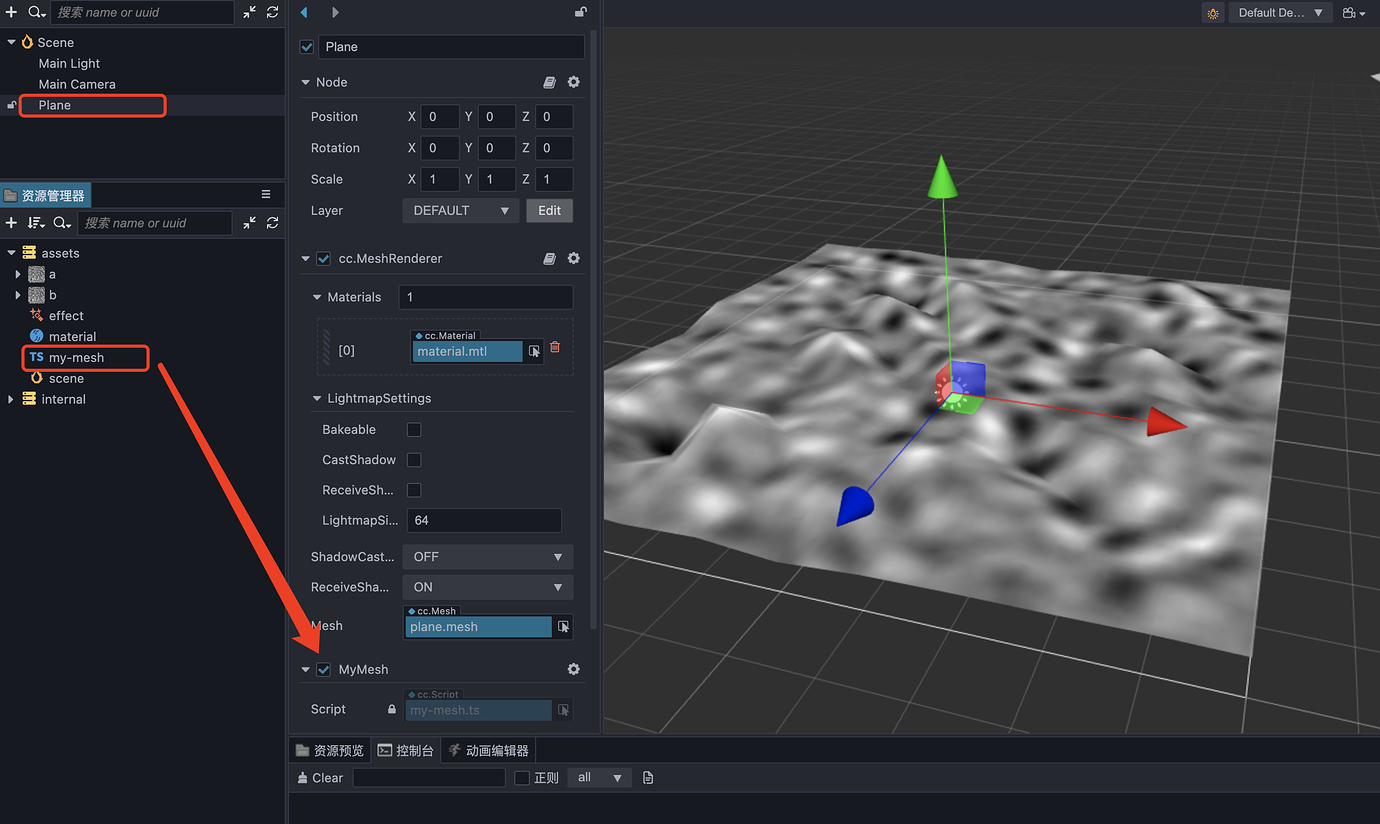 image
image
回到 Cocos,将脚本和 Node 绑定起来,并且运行
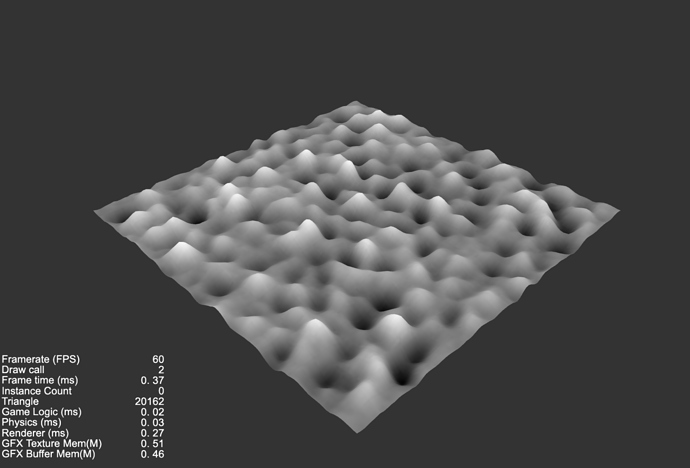 image
image
可以看到,相对编辑器中的已经平滑了许多,并且很容易的区分出高低的颜色
3.8 运动
引入时间戳(单位:s),根据时间的不同, 获取不同位置的 uv 信息,就可以让画面滚动起来 #incloud
1
2
3
4
5
6
7
8
9
10
11
12
13
14
15
16
17
18
19
20
21
22
23
24
25
26
27
28
29
30
31
32
33
34
35
36
| uniform sampler2D mainTexture;
#include <cc-global>
vec4 vert () {
StandardVertInput In;
CCVertInput(In);
mat4 matWorld, matWorldIT;
CCGetWorldMatrixFull(matWorld, matWorldIT);
vec4 p = In.position;
float y = texture(mainTexture, a_texCoord + cc_time.x * 0.1).x;
p.y = y;
vec4 pos = matWorld * p;
v_position = pos.xyz;
v_normal = normalize((matWorldIT * vec4(In.normal, 0.0)).xyz);
v_tangent = normalize((matWorld * vec4(In.tangent.xyz, 0.0)).xyz);
v_bitangent = cross(v_normal, v_tangent) * In.tangent.w;
v_uv = a_texCoord;
#if HAS_SECOND_UV
v_uv1 = a_texCoord1;
#endif
v_color = a_color;
CC_TRANSFER_FOG(pos);
CC_TRANSFER_SHADOW(pos);
return cc_matProj * (cc_matView * matWorld) * p;
}
}%
|
3.8.1 引入 #incloud cc-global
3.8.2 修改 uv 的获取,a_texCoord 值加上 cc_time.x 并且*一个速度系数 0.1
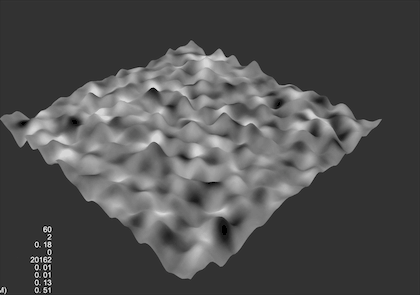 QQ20220115-180258
QQ20220115-180258
3.9 颜色
形状是发生改变了,但是颜色好像并没有重新发生变化
3.9.1 修改顶点着色器,将 texture 函数获取到的颜色,直接丢给 v_color
3.9.2 修改片元着色器,直接将 v_color 颜色返回【记得先声明 in vec4 v_color;】
1
2
3
4
5
6
7
8
9
10
11
12
13
14
15
16
17
18
19
20
21
22
23
24
25
26
27
28
29
30
31
32
33
34
35
36
37
38
39
40
41
42
43
44
45
46
47
48
49
50
51
52
53
54
55
56
57
58
59
60
61
62
63
64
65
66
67
68
69
70
71
72
73
74
75
76
77
| CCProgram my-vs %{
precision highp float;
#include <input-standard>
#include <cc-global>
#include <cc-local-batch>
#include <input-standard>
#include <cc-fog-vs>
#include <cc-shadow-map-vs>
in vec4 a_color;
#if HAS_SECOND_UV
in vec2 a_texCoord1;
#endif
out vec3 v_position;
out vec3 v_normal;
out vec3 v_tangent;
out vec3 v_bitangent;
out vec2 v_uv;
out vec2 v_uv1;
out vec4 v_color;
uniform sampler2D mainTexture;
#include <cc-global>
vec4 vert () {
StandardVertInput In;
CCVertInput(In);
mat4 matWorld, matWorldIT;
CCGetWorldMatrixFull(matWorld, matWorldIT);
vec4 p = In.position;
vec4 baseColor0 = texture(mainTexture, a_texCoord + cc_time.x * 0.1);
p.y = baseColor0.x;
vec4 pos = matWorld * p;
v_position = pos.xyz;
v_normal = normalize((matWorldIT * vec4(In.normal, 0.0)).xyz);
v_tangent = normalize((matWorld * vec4(In.tangent.xyz, 0.0)).xyz);
v_bitangent = cross(v_normal, v_tangent) * In.tangent.w;
v_uv = a_texCoord;
#if HAS_SECOND_UV
v_uv1 = a_texCoord1;
#endif
v_color = baseColor0;
CC_TRANSFER_FOG(pos);
CC_TRANSFER_SHADOW(pos);
return cc_matProj * (cc_matView * matWorld) * p;
}
}%
CCProgram unlit-fs %{
precision highp float;
#include <output>
#include <cc-fog-fs>
in vec2 v_uv;
in vec4 v_color;
uniform sampler2D mainTexture;
uniform Constant {
vec4 mainColor;
};
vec4 frag () {
return v_color;
}
}%
|
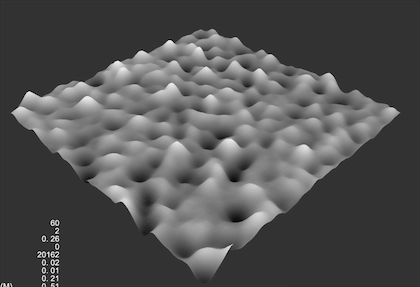 image
image
可以发现没有刚刚的问题了,回到越白的地方越高,越黑的地方越暗了
3.10 噪声叠加【翻涌】
噪声可以用多张,也可以读取多次,只要读取的位置不一样,并且叠加起来,那么就可以得到翻涌的感觉了 说上来可以比较抽象,实际行动下
1
2
3
4
5
6
7
8
9
10
11
12
13
14
15
16
17
18
19
20
21
22
23
24
25
26
27
28
29
30
31
32
33
34
| vec4 vert () {
StandardVertInput In;
CCVertInput(In);
mat4 matWorld, matWorldIT;
CCGetWorldMatrixFull(matWorld, matWorldIT);
vec4 p = In.position;
vec4 tiling0 = vec4(1.0, 1.0, 0.1, 0.1);
vec4 tiling1 = vec4(1.0, 1.0, 0.07, 0.07);
vec4 baseColor0 = texture(mainTexture, a_texCoord * tiling0.xy + cc_time.x * tiling0.zw);
vec4 baseColor1 = texture(mainTexture, a_texCoord * tiling1.xy + cc_time.x * tiling1.zw);
p.y = (baseColor0.x + baseColor1.x) * 0.5 - 0.5;
vec4 pos = matWorld * p;
v_position = pos.xyz;
v_normal = normalize((matWorldIT * vec4(In.normal, 0.0)).xyz);
v_tangent = normalize((matWorld * vec4(In.tangent.xyz, 0.0)).xyz);
v_bitangent = cross(v_normal, v_tangent) * In.tangent.w;
v_uv = a_texCoord;
#if HAS_SECOND_UV
v_uv1 = a_texCoord1;
#endif
v_color = (baseColor0 + baseColor1)* 0.5;
CC_TRANSFER_FOG(pos);
CC_TRANSFER_SHADOW(pos);
return cc_matProj * (cc_matView * matWorld) * p;
}
|
3.10.1 定义了 tiling0 和 tiling1,其中,xy 用来控制 uv 的倍率,zw 用来控制 uv 移动的方向
3.10.2 texture 采样两次,分别为 baseColor0 何 baseColor1,并且两个颜色的红色加起来*0.5,赋值给 p.y
3.10.3 p.y 最后还- 0.5,是因为 y 的值原本在 0~1 之间,希望最后在-0.5~0.5 之间分布,所以整体-0.5
3.10.4 将 v_color = baseColor0 改成 v_color = (baseColor0 + baseColor1)* 0.5;
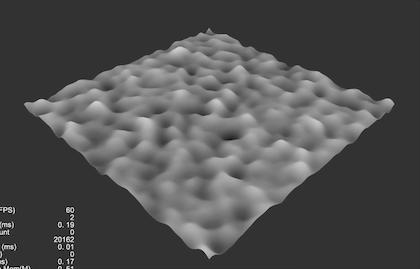 QQ20220115-182225
QQ20220115-182225
可以发现运动不再和上面一样单一运动,而是带上起伏的感觉
3.11 颜色过渡
黑白灰毕竟不好看,所以希望自定义两个颜色来重新定义高低
1
2
3
4
| vec4 c0 = vec4(1.0, 0.0, 0.0, 1.0);
vec4 c1 = vec4(0.0, 1.0, 0.0, 1.0);
v_color = (p.y + 0.5) * (c0 - c1) + c1;
|
定义两个颜色 c0 和 c1,用来表示最高处和最低处的两个地方的颜色 c0 表示最高处的颜色 c1 表示最低处的颜色 c0 - c1= 两个颜色的差距 p.y + 0.5 得到一个 0~1 之间的值,用来表示当前 y 的高度 (p.y + 0.5) _ (c0 - c1)得到一个 y 高度变化中的过渡值 过渡值+c1,表示过渡值+基础值=最终的颜色 c0 - c1 等于两个颜色分量的差,用差_(y + 0.5)得到变化值,最后在加上 c1
 QQ20220115-183306
QQ20220115-183306
这样就得到了一个自定义颜色的 shader
3.12 将定义的数据暴露给材质面板
目前位置,这里定义了两个 tiling,两个颜色 c0 和 c1
1
2
3
4
5
6
7
8
9
10
11
12
13
14
15
16
17
18
19
20
21
22
23
24
25
26
| CCEffect %{
techniques:
- name: opaque
passes:
- vert: my-vs:vert
frag: unlit-fs:frag
properties: &props
mainTexture: { value: white }
mainColor: { value: [1, 1, 1, 1], editor: { type: color } }
c0: { value: [1, 0, 0, 1], editor: { type: color } }
c1: { value: [0, 1, 0, 1], editor: { type: color } }
tiling0: { value: [1.0, 1.0, 0.1, 0.1] }
tiling1: { value: [1.0, 1.0, 0.07, 0.07] }
- name: transparent
passes:
- vert: general-vs:vert
frag: unlit-fs:frag
blendState:
targets:
- blend: true
blendSrc: src_alpha
blendDst: one_minus_src_alpha
blendSrcAlpha: src_alpha
blendDstAlpha: one_minus_src_alpha
properties: *props
}%
|
将 c0, c1, tiling0, tiling1 定义到 properties 里面,原来的参数这里先不做任何删改,保留处理 给顶点着色器和片元着色器都加上 uniform 声明定义块
1
2
3
4
5
6
| uniform MyVec4 {
vec4 c0;
vec4 c1;
vec4 tiling0;
vec4 tiling1;
};
|
然后移除原本代码里面定义的 c0, c1, tiling0 和 tiling1,用 uniform 来代替
最终完整的 effect 文件内容为:
1
2
3
4
5
6
7
8
9
10
11
12
13
14
15
16
17
18
19
20
21
22
23
24
25
26
27
28
29
30
31
32
33
34
35
36
37
38
39
40
41
42
43
44
45
46
47
48
49
50
51
52
53
54
55
56
57
58
59
60
61
62
63
64
65
66
67
68
69
70
71
72
73
74
75
76
77
78
79
80
81
82
83
84
85
86
87
88
89
90
91
92
93
94
95
96
97
98
99
100
101
102
103
104
105
106
107
108
109
110
111
112
113
114
115
116
117
118
119
120
121
122
123
|
CCEffect %{
techniques:
- name: opaque
passes:
- vert: my-vs:vert # builtin header
frag: unlit-fs:frag
properties: &props
mainTexture: { value: white }
mainColor: { value: [1, 1, 1, 1], editor: { type: color } }
c0: { value: [1, 0, 0, 1], editor: { type: color } }
c1: { value: [0, 1, 0, 1], editor: { type: color } }
tiling0: { value: [1.0, 1.0, 0.1, 0.1] }
tiling1: { value: [1.0, 1.0, 0.07, 0.07] }
- name: transparent
passes:
- vert: general-vs:vert # builtin header
frag: unlit-fs:frag
blendState:
targets:
- blend: true
blendSrc: src_alpha
blendDst: one_minus_src_alpha
blendSrcAlpha: src_alpha
blendDstAlpha: one_minus_src_alpha
properties: *props
}%
CCProgram my-vs %{
precision highp float;
#include <input-standard>
#include <cc-global>
#include <cc-local-batch>
#include <input-standard>
#include <cc-fog-vs>
#include <cc-shadow-map-vs>
in vec4 a_color;
#if HAS_SECOND_UV
in vec2 a_texCoord1;
#endif
out vec3 v_position;
out vec3 v_normal;
out vec3 v_tangent;
out vec3 v_bitangent;
out vec2 v_uv;
out vec2 v_uv1;
out vec4 v_color;
uniform sampler2D mainTexture;
uniform MyVec4 {
vec4 c0;
vec4 c1;
vec4 tiling0;
vec4 tiling1;
};
#include <cc-global>
vec4 vert () {
StandardVertInput In;
CCVertInput(In);
mat4 matWorld, matWorldIT;
CCGetWorldMatrixFull(matWorld, matWorldIT);
vec4 p = In.position;
vec4 baseColor0 = texture(mainTexture, a_texCoord * tiling0.xy + cc_time.x * tiling0.zw);
vec4 baseColor1 = texture(mainTexture, a_texCoord * tiling1.xy + cc_time.x * tiling1.zw);
p.y = (baseColor0.x + baseColor1.x) * 0.5 - 0.5;
vec4 pos = matWorld * p;
v_position = pos.xyz;
v_normal = normalize((matWorldIT * vec4(In.normal, 0.0)).xyz);
v_tangent = normalize((matWorld * vec4(In.tangent.xyz, 0.0)).xyz);
v_bitangent = cross(v_normal, v_tangent) * In.tangent.w;
v_uv = a_texCoord;
#if HAS_SECOND_UV
v_uv1 = a_texCoord1;
#endif
v_color = (p.y + 0.5) * (c0 - c1) + c1;
CC_TRANSFER_FOG(pos);
CC_TRANSFER_SHADOW(pos);
return cc_matProj * (cc_matView * matWorld) * p;
}
}%
CCProgram unlit-fs %{
precision highp float;
#include <output>
#include <cc-fog-fs>
in vec2 v_uv;
in vec4 v_color;
uniform sampler2D mainTexture;
uniform Constant {
vec4 mainColor;
};
uniform MyVec4 {
vec4 c0;
vec4 c1;
vec4 tiling0;
vec4 tiling1;
};
vec4 frag () {
return v_color;
}
}%
|
回到 cocos 中,查看材质
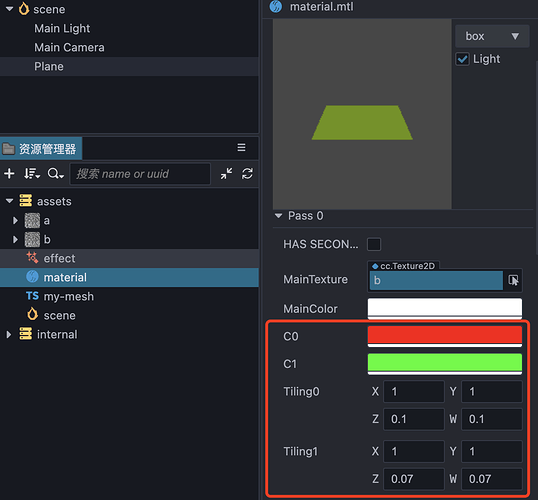 image
image
4. 成果
调整一下摄像机,材质的参数
 QQ20220115-185126
QQ20220115-185126
4.1 最小可预览工程
版本:CocosCreator 3.3.1 learn.zip|attachment (45.8 KB)
























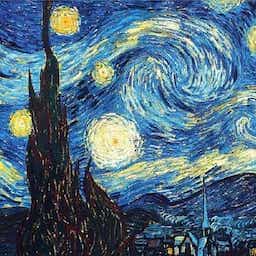
v1.5.2